Cretaceous period: Animals, plants and extinction event
The Cretaceous period was the last segment of the Mesozoic era.
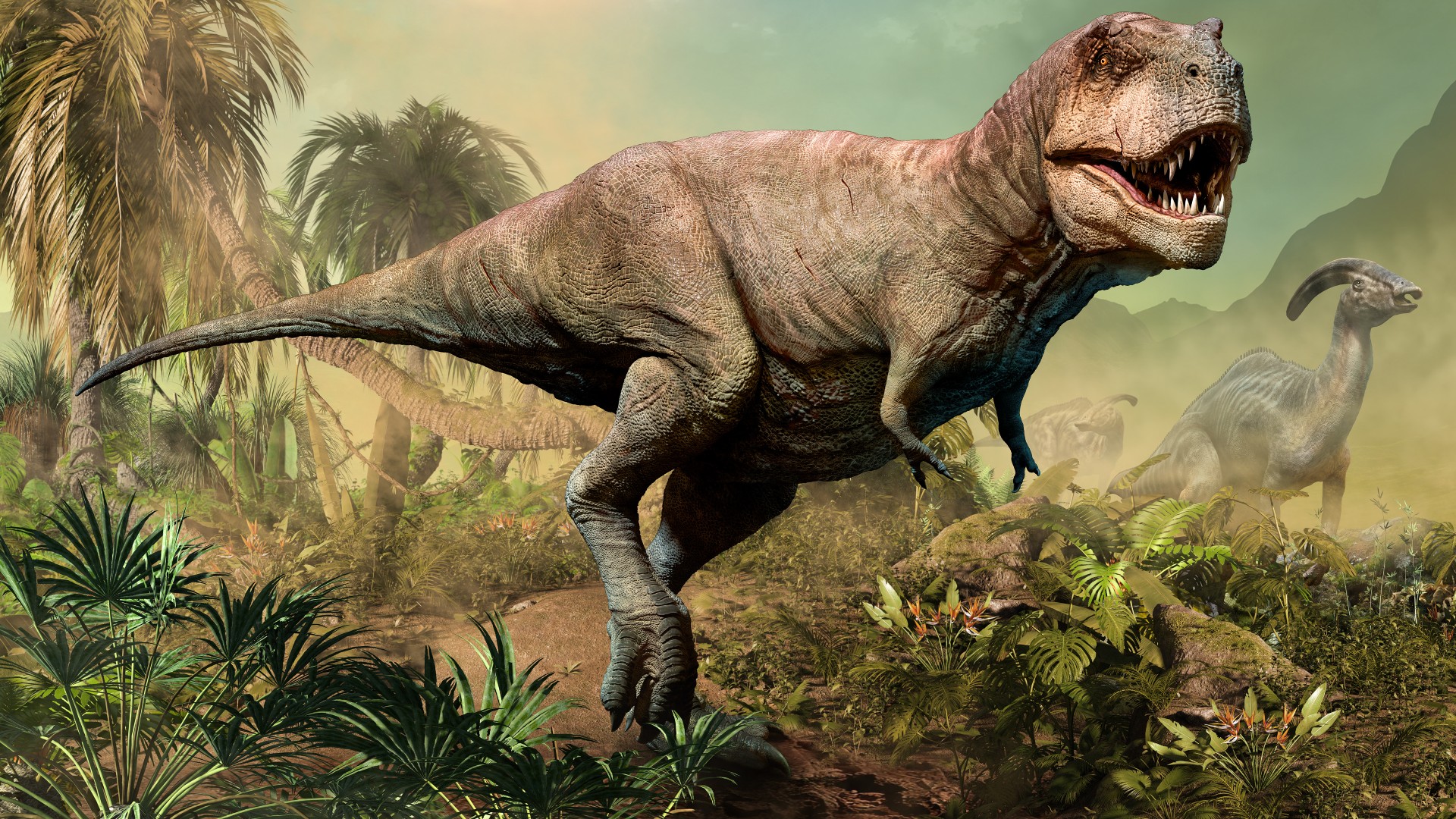
The Cretaceous period was the last and longest segment of the Mesozoic era. It lasted approximately 79 million years, from the minor extinction event that closed the Jurassic period about 145 million years ago to the Cretaceous-Paleogene (K-Pg) extinction event 66 million years ago. The name comes from "creta," the Latin word for chalk, because of widespread chalk deposits dating from the period, according to the National Park Service.
In the early Cretaceous, the continents were in very different positions than they are today, according to the Australian Museum. Sections of the supercontinent Pangaea were drifting apart. The Tethys Ocean still separated the northern continent Laurasia from the southern continent Gondwana. The North and South Atlantic were still closed, although the Central Atlantic had begun to open up in the Late Jurassic period. By the middle of the Cretaceous period, ocean levels were much higher; most of the landmasses we are familiar with were underwater. By the end of the period, the continents were much closer to their modern configuration. Africa and South America had assumed their distinctive shapes. But India had not yet collided with Asia, and Australia was still part of Antarctica.
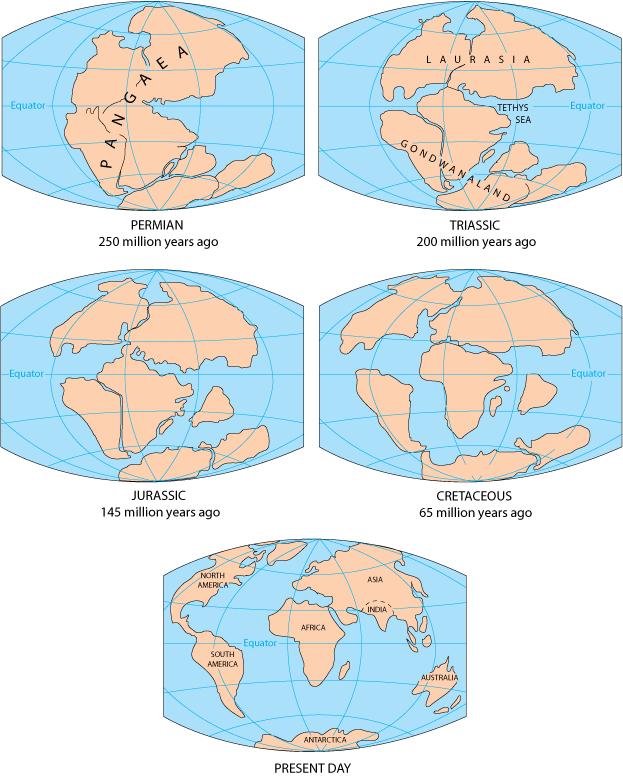
Cretaceous period plants
One hallmark of the Cretaceous period was the development and radiation of flowering plants, or angiosperms, which "rapidly diversified," according to the National Park Service. This radiation "gave rise suddenly and mysteriously to exquisite angiosperm diversity in the mid-Cretaceous," an evolutionary development that troubled Charles Darwin, who saw evolution happening much more slowly, according to a review in the journal Proceedings of the Royal Society B. Darwin proposed that flowering plants must have started developing long before the Cretaceous, potentially on "a lost island or continent," William E. Friedman, an evolutionary biologist at Harvard University, wrote in the American Journal of Botany in 2009. However, the Cretaceous-era burst of floral development may instead reveal how evolution can happen very quickly, Friedman wrote.
Though Darwin's lost continent never showed up, some flowering plants may have appeared in the Jurassic, recent research has shown.
However, Jurassic-era flowering plants would have been uncommon and may also have been evolutionary links between older plants that resembled angiosperms and the real thing, found in the Cretaceous, researchers said. Scientists generally place "the oldest uncontested" angiosperm fossils at about 125 million to 130 million years ago, in the early Cretaceous, according to the Brooklyn Botanic Garden. These include plants of the genera Archaefructus and Montsechia, which show the first evidence of ovaries in plants but may have lacked petals.
Since Darwin, scientists have thought that pollinating insects, such as bees and wasps, played a key role in the Cretaceous explosion of flowering plants, according to recent and foundational research. This is frequently cited as an example of co-evolution, according to the Washington Native Plant Society.
The mid-Cretaceous saw abundant populations of both insects and flowering plants, and recent finds finally caught Cretaceous-era insect pollinators frozen in the act. In 2019, scientists reported in the journal Proceedings of the National Academy of Sciences the first direct fossil evidence of insect pollination in the Cretaceous: a tumbling flower beetle, Angimordella burmitina, preserved in amber since the mid-Cretaceous, 99 million years ago, and covered with pollen grains. The beetle sports several body parts specialized for feeding on flowers, including pollen-feeding mouthparts, and the pollen grains have traits, like clumping characteristics, associated with insect pollination, the researchers reported.
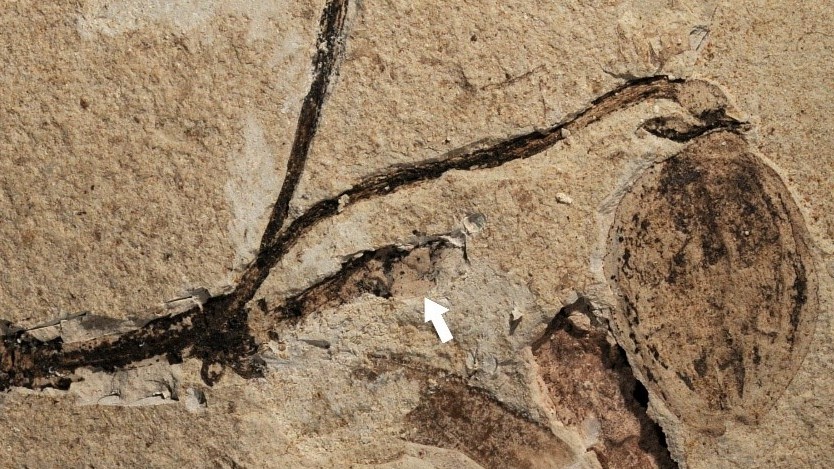
And in a 2020 paper published in the journal BioOne, scientists reported on the oldest bee found bearing pollen, the 100 million-year-old Discoscapa apicula. Also found encased in amber, this insect shared some traits with modern bees, such as hind legs laden with pollen, and some traits with wasps, such as its wing vein features.
Thanks to pollinating insects, flowering plants had tremendous advantages over plants that spread pollen only by wind, spurring the explosion of angiosperms, according to Illinois Extension at the University of Illinois Urbana-Champaign. Competition for insect attention probably facilitated the relatively rapid success and diversification of the flowering plants, "lead[ing] to the development of many different size, shapes, colors and fragrances of flowers we see today,” including the production of nectar to attract hungry bugs. As diverse flower forms lured insects to pollinate them, insects adapted to different ways of gathering nectar and moving pollen, thus setting up the intricate co-evolutionary systems found to this day.
A few finds over the decades have estimated that some pollinating insects arrived before flowering plants. In 2009, researchers found that 11 species of scorpionflies present starting in the middle Jurassic boasted the elongated mouthparts and pollen-centric diets characteristic of pollinators, as reported in the journal Science. These likely pollinating insects, however, fed on nonflowering plants, or angiosperms, "long before the similar and independent coevolution of nectar-feeding flies, moths and beetles on angiosperms," the study said. These critters went extinct during the Cretaceous, around the time of the "global gymnosperm-to-angiosperm turnover," the researchers said. In the 1990s, researchers reported that bee- or wasp-like insects built hive-like nests in what is now called the Petrified Forest in Arizona, dating back to more than 200 million years ago. However, later re-evaluations found that the structures lacked defining characteristics of bee nests and most likely came from beetle larva chambers or other creatures, as reported in the journal Palaeogeography, Palaeoclimatology, Palaeoecology. That evaluation of the structures "eliminates them as evidence that decouples bee origins from the Cretaceous origin of angiosperms," the scientists wrote.
Some evidence shows that dinosaurs ate flowering plants. Two dinosaur coprolites (fossilized excrements) discovered in Utah contain fragments of angiosperm wood, according to an unpublished study presented at the 2015 Society of Vertebrate Paleontology annual meeting. An Early Cretaceous ankylosaur was found with fossilized angiosperm fruit in its gut.
However, for the most part, evidence suggests that dinosaurs ignored angiosperms in the Cretaceous, maintaining a diet focused on ferns and conifers, University of Bristol researchers said in 2021, summarizing their work on angiosperm evolution in the journal New Phytologist. The shape of some teeth from Cretaceous animals suggests that the herbivores grazed on leaves and twigs, said Betsy Kruk, formerly a volunteer researcher at the Field Museum in Chicago and now a principal investigator and project manager at Material Culture Consulting, a California-based company that consults on compliance services including archaeology and paleontology.
Cretaceous period animals
The Cretaceous was an age of reptiles. Dinosaurs dominated the land, while marine reptiles like the mosasaurs — which could span 56 feet (17 meters) — swam the oceans. Pterosaurs plied the skies, including the largest flying animal ever, Quetzalcoatlus, whose wingspan could stretch to 36 feet (11 m).
The largest-ever land predator, the famous Tyrannosaurus rex, also reigned during the Cretaceous. By the end of the Jurassic, some large sauropods, such as Apatosaurus and Diplodocus, had gone extinct. But other giant sauropods, including the titanosaurs, flourished, especially toward the end of the Cretaceous, Kruk said. Titanosaurs were the most successful sauropods of the period, and the past two decades have seen a "boom" in titanosaur discoveries, according to the journal Nature Ecology & Evolution.
Large herds of herbivorous ornithischians also thrived during the Cretaceous. These included Iguanodon (which belongs to the same group as duck-billed dinosaurs, also known as hadrosaurs), Ankylosaurus, and the ceratopsians, like Triceratops. Duck-billed dinosaurs were the most common type of ornithischians, a group of mostly herbivorous dinosaurs with bird-like hips, according to the Cal Poly Humboldt Natural History Museum. Theropods, including T. rex, continued as apex predators until the end of this period.
During the Cretaceous, more ancient birds took flight, joining the pterosaurs in the air. Experts have long debated the origin of flight. According to the so-called trees down theory, small reptiles may have evolved flight from gliding behaviors. The ground up hypothesis posits that flight evolved from the ability of small theropods to leap high to grasp prey or evade predators. Early research suggested that feathers evolved from elongated scales whose primary function, at least at first, was thermoregulation. They could be moved to absorb more solar heat in cool conditions and provide protection from the sun when it was hot, according to a 1975 study in The Quarterly Review of Biology. More recent studies suggest that signaling and tactile sensing may also have played a role in the evolution of these feather precursors, according to a study in the International Journal of Organic Evolution.
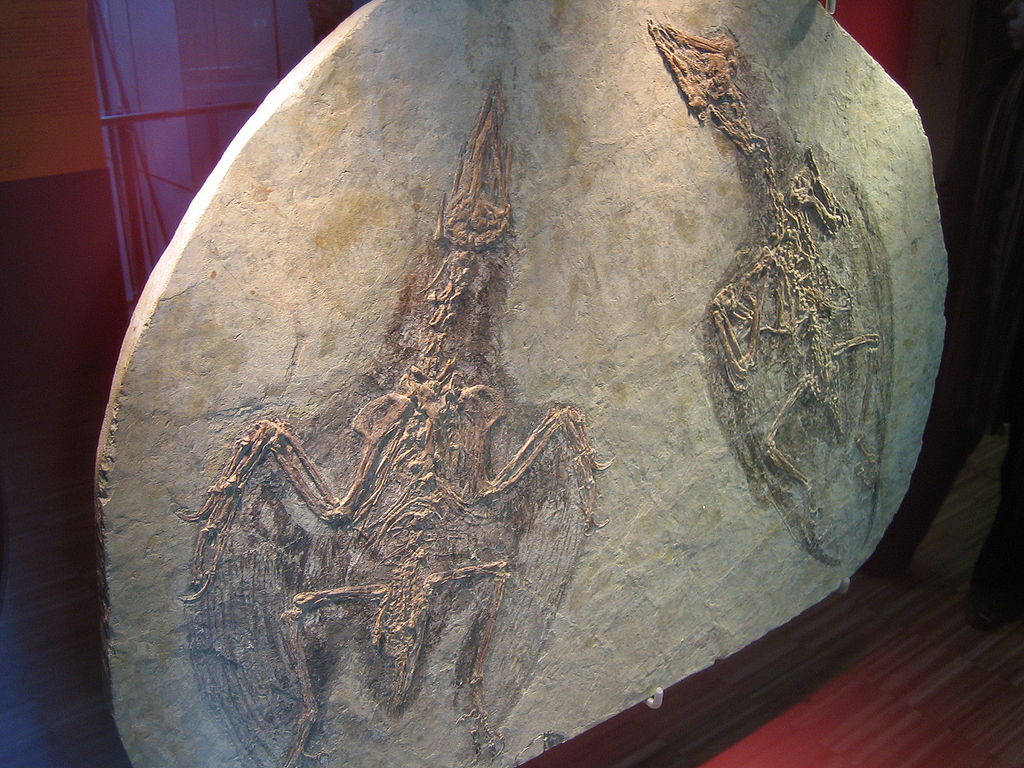
The earliest fossilized bird, Archaeopteryx, swooped through Cretaceous skies 150 million years ago, though it resembled small dinosaurs more than the birds we see today, according to the Australian Museum. A variety of birds arrived on the scene soon afterward sporting a range of features that could be more like those of current birds. Some of these creatures evolved into birds of the modern type by the late Cretaceous, which means that "bird-like dinosaurs, primitive birds and early modern birds all co-existed" for a stretch of the Cretaceous, the Australian Museum added.
One Cretaceous-era bird, Confuciusornis sanctus, lived about 125 million years ago. It was a crow-size bird with a modern, toothless beak, unlike the fanged Archaeopteryx; claws similar to those of modern, tree-dwelling birds; and flight-worthy feathers. A study of pigment-storing cell organelles in C. sanctus in the journal Science found that these ancient birds likely sported dark feathers on their torsos, with lighter-colored wings, according to the California Academy of Sciences. Iberomesornis, a contemporary of Archaeopteryx only the size of a sparrow, was capable of flight and may have been an insectivore.
Related: Are birds dinosaurs?
Sea creatures also thrived during the Cretaceous, with many marine groups reaching their peak levels of diversity, according to the Cal Poly Humboldt museum. Beyond the mosasaurs, ocean sea life included mollusks that built reefs comparable to today's coral reefs, along with sharks, lobsters and crabs, sand dollar-like creatures known as echinoids, and a type of bony fish known as ray-finned fish (named for their fins formed from spines draped with webs of skin).
Though reptiles ruled the Cretaceous world, early mammals did exist at the time. Traditionally, scientists have viewed mammal evolution as constrained by the dominant dinosaurs; mammals couldn't evolve many species types, because dinosaurs occupied most niches, this view suggests. Only after the mass extinction that killed off all nonavian dinosaurs could mammals "radiate," or evolve into many diverse forms. But mammals may have gone through radiations even during the dinosaur age, including the Jurassic and Cretaceous periods, a 2019 study in the journal Trends in Ecology and Evolution found. And a 2021 study in the journal Current Biology found that evolutionary suppression of therians, the ancestors of today's mammals, may have come from not only dinosaurs, but also ancient relatives of mammals known as mammaliaforms.
How did the Cretaceous period end?
About 66 million years ago, nearly all large vertebrates and many tropical invertebrates became extinct in one of Earth's five great mass extinction events, according to former University of California, Davis, Earth and planetary sciences professor Richard Cowen. Scientists have linked that mass extinction with an enormous asteroid that collided with Earth in what is now Mexico. The event killed off all nonavian dinosaurs, all pterosaurs (which were not dinosaurs) and many marine reptiles, including mosasaurs and plesiosaurs, as well as many early mammals and "a host of amphibians, birds, reptiles and insects," according to the American Museum of Natural History in New York. An estimated three-quarters of species alive at the time met their end.
Related: What happened when the dinosaur-killing asteroid slammed into Earth?
Geologists call this mass die-off the K-Pg extinction event because it marks the boundary between the Cretaceous and Paleogene periods; the "K" is from "Kreide," the German word for Cretaceous. The event was formerly known as the Cretaceous-Tertiary (K-T) event, but the group that sets standards for geologic nomenclature now considers Tertiary out of date with current science, according to the National Commission for Stratigraphy Belgium.
The Chicxulub (CHEEK-sheh-loob) crater in the Yucatán Peninsula, which spans more than 110 miles (180 kilometers) in diameter, is the likely landing spot of the dinosaur-killing asteroid. This crater dates to within 33,000 years of the K-Pg event, Live Science previously reported. "We've shown the impact and the mass extinction coincided as much as one can possibly demonstrate with existing dating techniques," Paul Renne, lead scientist in that study and a geochronologist and director of the Berkeley Geochronology Center in California, previously told Live Science.
Scientists had first associated the K-Pg extinction with an extraterrestrial impact decades ago, however. In 1979, a geologist discovered that the thin layer of clay separating the Cretaceous and Paleogene periods contained high concentrations of iridium. This element is rare on Earth but much more common in meteorites and asteroids, according to the Lunar and Planetary Science Institute. Other researchers found "shocked quartz," a form of the mineral created under intense pressure, and tiny, glass-like globes called tektites that form from droplets of melted rock. Both of these geological features form when an extraterrestrial object strikes Earth with great force.
Research in 2020 found that the object that carved out Chicxulub hit Earth at the most destructive possible angle, Live Science previously reported. The 7.5-mile-wide (12 km) asteroid, traveling at about 27,000 mph (43,000 km/h), would have vaporized rocks, sending 325 gigatons of sulfur and 435 gigatons of carbon dioxide into the atmosphere in the form of pulverized rock and sulfuric acid droplets, researchers estimated.
When the asteroid collided with Earth, its impact would have triggered a 10.1-magnitude earthquake, sent a shock wave with "hurricane-force winds" rippling across the Americas, and spawned a 330- to 820-foot-high (100 to 250 m) tsunami, according to a 2021 University of Maryland course. As debris ejected by the impact fell back to Earth, the material would have cooked the atmosphere to 2,700 degrees Fahrenheit (1,482 degrees Celsius), painting the sky red for several hours and igniting forest fires across the planet, Live Science reported in 2013. The heat pulse was like a global broiler oven, not only burning vegetation, but also cooking living things unable to burrow or dive, the researchers said.
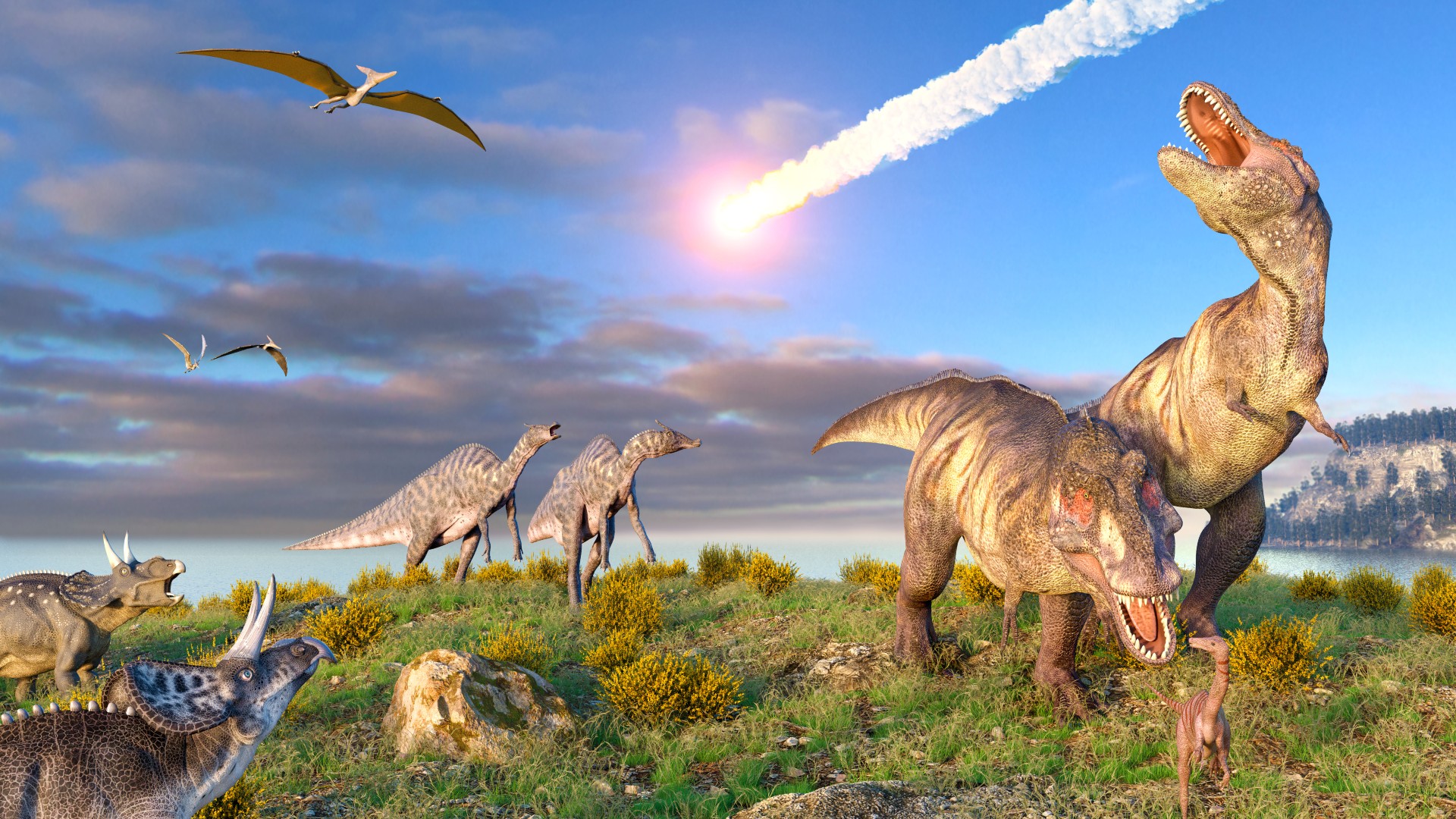
"This rain of hot dust raised global temperatures for hours after the impact and cooked alive animals that were too large to seek shelter," Kruk said. "Small animals that could shelter underground, underwater, or perhaps in caves or large tree trunks, may have been able to survive this initial heat blast."
Rock vaporized by the asteroid likely stayed in the atmosphere, blocking part of the sun's rays for months or years, according to the University of Maryland. This may even have lasted as long as 16 years, with a 30-year recovery period. With less sunlight, plants would have died, with consequences traveling up the food chain to herbivores dependent on plants and carnivores dependent on those herbivores, according to the Natural History Museum in London.
Furthermore, the reduced sunlight would have drastically lowered global temperatures, which plunged in the tropics from 81 F (27 C) to 41 F (5 C), Live Science previously reported. The newly frigid climate would have impaired large active animals with high-energy needs, Kruk said.
"Smaller, omnivorous terrestrial animals — like mammals, lizards, turtles or birds — may have been able to survive as scavengers feeding on the carcasses of dead dinosaurs, fungi, roots and decaying plant matter, while smaller animals with lower metabolisms were best able to wait the disaster out," she said.
The last phase of the asteroid fallout, greenhouse warming, may have lasted around 100,000 years, according to the University of Maryland. Carbonite rocks oxidized by the impact would have released large amounts of the greenhouse gas carbon dioxide (CO2) into the atmosphere. Just before the impact, a series of what may have been the second-largest volcanic eruptions ever on land went off at the Deccan traps in western India, according to the American Museum of Natural History. These regional catastrophes had already spewed tremendous levels of CO2 and so likely combined with the asteroid fallout to heat up the planet once the sun-obscuring dust settled, according to the University of Maryland.
Cretaceous period climate
Even before global cataclysms spurred global warming, the world was a warmer place during the Cretaceous period than it is today, according to Climate Policy Watcher. The poles were cooler than the lower latitudes, but "overall, things were warmer," Kruk told Live Science. Fossils of tropical plants and ferns support this idea, she said. Warm ocean currents, unfrozen poles and levels of CO2 that were relatively high even before the extinction event all combined to produce a hot planet, according to Climate Policy Watcher.
Animals in the Cretaceous lived all over, even in colder areas. For instance, Hadrosaur fossils dating to the Late Cretaceous were uncovered in Alaska. And in a 2020 paper in the journal Nature, scientists reported on a temperate rainforest in Antarctica dating to the mid-Cretaceous.
Additional resources
Learn about and visit a cast of a titanosaur, the gigantic sauropods of the Cretaceous era, at the American Museum of Natural History. Explore the Cretaceous-Paleogene extinction and Earth's four other mass extinction events, including the possibility that we've entered a new one, at the Natural History Museum in London. Discover how pollinators and flowers have co-evolved at the New England Primate Conservancy. Read Richard Cowen's essay on the K-Pg mass extinction event and other topics in his book "History of Life" (Blackwell Scientific Publications, 2000).
This article was originally written by Live Science contributor Mary Bagley with contributions from Live Science editor Laura Geggel.
Originally published on Live Science on January 8, 2016 and updated on July 26, 2022.
Sign up for the Live Science daily newsletter now
Get the world’s most fascinating discoveries delivered straight to your inbox.

Michael Dhar is a science editor and writer based in Chicago. He has an MS in bioinformatics from NYU Tandon School of Engineering, an MA in English literature from Columbia University and a BA in English from the University of Iowa. He has written about health and science for Live Science, Scientific American, Space.com, The Fix, Earth.com and others and has edited for the American Medical Association and other organizations.










